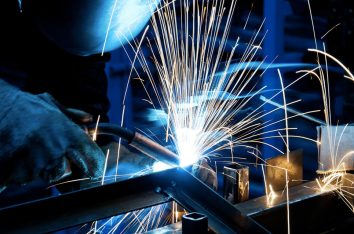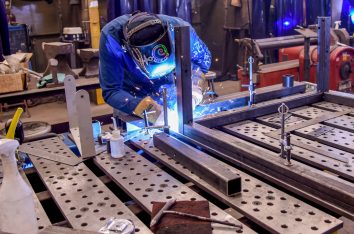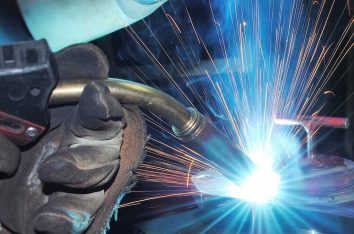Understanding the Basics: What is Welding and How Does it Work?
Welding, a critical process in both industrial and creative contexts, involves the fusion of materials, typically metals, through the application of heat, pressure, or both. This guide aims to demystify the basics of welding, from its historical evolution to modern applications and provides insights into the various types of welding processes, equipment, and safety practices. Whether you're exploring welding as a potential career or simply as a hobby, understanding these fundamentals is essential for anyone interested in this transformative craft.
Key Takeaways
- Welding is the process of joining two materials by melting them together with heat, pressure, or both, often using a filler material to strengthen the bond.
- Various welding techniques, such as MIG, TIG, and stick welding, cater to different materials and applications, each with its advantages and limitations.
- Proper welding equipment, including safety gear and welding machines, is crucial for effective and safe welding practices.
- Understanding welding joints and their characteristics is key to selecting the right joint type for a specific project and achieving a strong, defect-free weld.
- Welding offers a wide range of career opportunities and requires a combination of technical knowledge, hands-on training, and safety awareness.
The Essence of Welding
Welding is a crucial process that involves joining two or more pieces of metal by applying heat, pressure, or a combination of both. It is an essential skill in various industries, including construction, manufacturing, and automotive. The essence of welding lies in its ability to create strong, durable, and reliable connections between metal components.
Definition and Core Concepts
Welding is the process of joining two materials, typically metals or thermoplastics, by causing coalescence. This is often done by melting the workpieces and adding a filler material to form a strong joint upon cooling. The core concept of welding revolves around the creation of a permanent bond between components through the application of heat, pressure, or both.
- Fundamental principles include the proper alignment of materials, control of heat input, and the use of flux to prevent oxidation during the welding process.
- Understanding the science behind welding is crucial for achieving strong and durable welds.
Historical Evolution
The history of welding dates back thousands of years, from simple forge welding techniques used by blacksmiths to the sophisticated methods developed in the 20th century. The evolution of welding technology has been driven by the demands of industry and construction, leading to innovations such as electric arc welding and the use of inert gases.
- Early welding methods were rudimentary and labor-intensive.
- Significant advancements have occurred over the past two centuries, revolutionizing the field of welding.
Modern Applications
Today, welding is indispensable in numerous industries, including automotive, aerospace, construction, and manufacturing. The versatility of welding allows for its application in both large-scale industrial projects and intricate custom work.
- Welding techniques are tailored to suit the specific requirements of different materials and projects.
- The ongoing development of new welding methods continues to expand the possibilities of what can be achieved through welding.
Welding Fundamentals
Welding fundamentals encompass the basic principles and concepts that form the foundation of this craft. Understanding the properties of metals, heat transfer mechanisms, and the physics behind the welding process is crucial for achieving successful welds. These fundamentals provide the necessary knowledge to select the appropriate welding method, materials, and techniques for a given application.
Materials and Metallurgy
Welding is a process that joins materials, typically metals, by causing coalescence. This is often done by melting the workpieces and adding a filler material to form a strong joint upon cooling. The selection of materials is crucial, as different metals and alloys have varying properties that affect the welding process and the final weld quality.
- Understanding the metallurgical properties of the base materials is essential for a successful weld.
- The compatibility of materials is key to preventing defects and ensuring structural integrity.
- Knowledge of material behavior under high temperatures guides the choice of welding method.
Heat and Pressure Dynamics
The application of heat and pressure is central to welding. These forces must be controlled to create a durable and reliable joint. Heat is applied to melt the base material and the filler, while pressure is used to fuse them together.
- The amount of heat and the duration of its application are critical factors in achieving a proper weld.
- Pressure must be applied uniformly to ensure a consistent weld bead and prevent weak spots.
- Techniques such as forge welding utilize heat and pressure without the need for a filler material.
The Role of Filler Materials
Filler materials are used in many welding processes to provide additional material for creating the weld joint. They must be compatible with the base materials and suit the specific welding process being used.
- Filler materials come in various forms, including rods, wires, and powders.
- In flux-cored arc welding, the filler wire contains a flux that protects the weld pool from contamination.
- The choice of filler material can significantly influence the mechanical properties and corrosion resistance of the weld.
Types of Welding Processes
There are various welding processes available, each with its unique characteristics and applications. Some common types include arc welding (e.g., shielded metal arc welding, gas metal arc welding), gas welding (e.g., oxy-fuel welding), resistance welding, and solid-state welding. Choosing the right process depends on factors such as the materials being welded, joint design, and project requirements.
Comparing Common Techniques
The landscape of welding is diverse, with numerous techniques tailored to different applications and materials. The four most common types of fusion welding are Gas Tungsten Arc Welding (GTAW/TIG), Gas Metal Arc Welding (GMAW/MIG), Shielded Metal Arc Welding (SMAW/Stick), and Flux-Cored Arc Welding (FCAW). Each type of weld offers unique benefits and is suited for specific conditions and metals.
- GTAW/TIG is renowned for its precision and quality, ideal for thin materials.
- GMAW/MIG is versatile and easy to learn, making it popular for both DIY and industrial applications.
- SMAW/Stick is portable and effective on dirty or rusty metals.
- FCAW is similar to MIG but includes a flux core, allowing for outdoor welding without additional shielding gas.
Specialized Welding Methods
Beyond the common techniques, specialized welding methods cater to specific industry needs. Processes such as plasma arc welding, electro-slag welding, and electron beam welding are employed for their distinct advantages in certain scenarios. For instance, electron beam welding is used when high precision and deep weld penetration are required, often in the aerospace and automotive industries.
Choosing the Right Process
Selecting the appropriate welding process is crucial for the success of a project. Factors to consider include the type of materials being joined, the desired strength of the weld, the position of the weld, and the available equipment. For example, resistance welding is often chosen for creating strong lap joints, while arc welding's versatility makes it suitable for a variety of joint types. Understanding the strengths and limitations of each welding method ensures optimal results.
Welding Equipment Essentials
Welding requires specialized equipment to ensure safe and efficient operations. Essential equipment includes welding machines, power sources, electrode holders, welding torches, personal protective equipment (PPE), and fume extraction systems. Proper selection, maintenance, and operation of these tools are crucial for achieving high-quality welds and ensuring the safety of welders and their surroundings.
Safety Gear and Tools
Welding is a task that demands the utmost attention to safety. Proper safety gear is non-negotiable and includes items such as welding helmets with auto-darkening technology, gloves, and protective jackets. Additionally, essential tools that support the welding process are crucial. These range from basic hand tools like wire brushes and chipping slag hammers to precision instruments such as soapstone markers and tape measures. Ensuring that you have a comprehensive set of tools not only facilitates a smoother workflow but also contributes to a safer working environment.
- Welding helmets
- Gloves
- Protective jackets
- Wire brushes
- Chipping slag hammers
- Soapstone markers
- Tape measures
Welding Machines and Power Sources
The heart of any welding setup is the welding machine. Selecting the right machine—whether it's a single-process or a multi-process welder—can make a significant difference in the quality and efficiency of your work. For different types of arc welding, such as MIG, Stick, or TIG, the appropriate power source is essential. High-quality equipment ensures not only better results but also longevity and reliability in your welding projects.
- Single process welders
- Multi-process welders
- Shielding gas
- Filler metal
Maintenance and Care
To maintain the performance and extend the lifespan of welding equipment, regular maintenance and care are imperative. This includes cleaning and inspecting tools and machines, replacing consumables like electrodes and tips, and ensuring that all safety gear is in good condition. A well-maintained setup not only prevents downtime but also upholds the highest standards of safety and quality in welding.
- Regular cleaning and inspection
- Replacement of consumables
- Safety gear upkeep
Understanding Welding Joints
Welding joints refer to the specific configurations and geometries of the metal components being joined. Common joint types include butt joints, lap joints, corner joints, and edge joints. Understanding the characteristics and requirements of each joint type is essential for selecting the appropriate welding process, joint preparation techniques, and welding parameters.
Characteristics of Different Joints
Weld joints are fundamental to the integrity of structures and machinery. The five basic types of weld joints are butt, lap, corner, edge, and T-joint, with variations such as the cruciform and double-V preparation joints. Each type has its specific applications and is chosen based on the desired strength, aesthetics, and requirements of the welding process.
- Butt Joint: Two pieces aligned in the same plane.
- Lap Joint: Overlapping pieces joined at the edges.
- Corner Joint: Two pieces at a right angle to each other.
- Edge Joint: The edges of two pieces placed side by side.
- T-Joint: A T-shaped assembly where the base of one piece is welded to the end of another.
Selection Criteria for Joint Types
Selecting the appropriate weld joint is crucial for project success. Factors influencing the choice include the welding process used, material thickness, and the mechanical loads the joint will bear. For instance, resistance spot welding and laser beam welding are often performed on lap joints, while processes like shielded metal arc welding offer versatility for various joint types.
Common Welding Defects
Welding defects can compromise the strength and appearance of a weld joint. Common issues include porosity, cracks, and incomplete fusion. To ensure a high-quality weld, it is essential to understand the welding process, select the right joint design, and execute the weld properly. Friction welding, for example, uses heat generated by friction to join materials, which can reduce the occurrence of certain defects.
The Welding Procedure
The welding procedure is a critical aspect of any fabrication process, encompassing a series of steps that ensure the integrity and strength of the welded joint. It involves meticulous preparation, precise execution, and thorough post-welding treatments to achieve the desired outcome.
Preparation Steps
- Select the appropriate welding method based on material compatibility and the intended application. Options include arc welding, mig welding, tig welding, gas welding, and plastic welding, among others.
- Ensure the surfaces to be welded are clean and free of contaminants to prevent defects.
- Assemble all necessary equipment, including safety gear, welding machines, and filler materials.
- Develop a welding procedure specification (WPS) to outline the proven techniques and parameters for the welding process.
Execution of the Weld
- Begin by applying the chosen welding technique, such as stick welding, submerged arc welding, or electron beam welding, following the WPS guidelines.
- Maintain a stable arc or flame throughout the welding process to ensure consistent quality.
- Use filler materials when necessary to reinforce the joint, selecting the right type for the welding method and base materials.
- Monitor the weld pool and adjust the heat input as needed to avoid overheating or insufficient penetration.
Post-Welding Treatments
- Inspect the weld using methods like visual inspection, radiography, or ultrasonic testing to ensure it meets quality standards.
- Perform any necessary post-weld heat treatments to relieve stresses and improve the metallurgical properties of the joint.
- Clean the welded area and apply protective coatings if required to prevent corrosion and enhance durability.
Throughout the welding procedure, safety precautions must be strictly followed to protect the welder and the environment. This includes the use of personal protective equipment and awareness of potential hazards associated with the specific welding process being employed.
Welding Safety and Best Practices
Safety is paramount in the welding industry. Welding operations involve high temperatures, bright light, and potential exposure to hazardous fumes and gases. Implementing best practices, such as wearing proper PPE, ensuring adequate ventilation, and following safety protocols, is crucial for protecting welders and those around them from potential risks and hazards.
Personal Protective Equipment
- Always wear personal protective equipment (PPE), including a welding helmet, gloves, and protective clothing.
- Choose materials for PPE that are flame-resistant, such as heavy leather, to prevent burns.
- Ensure that synthetic materials like polyester, which can burn and cause injury, are not part of the attire.
Hazard Awareness and Prevention
- Be aware of the risks associated with open electric arcs or flames in processes like shielded metal arc welding.
- Set up special welding screens to protect other workers from the welding arc's flash.
- Use appropriate ventilation or a respirator to mitigate the inhalation of welding fumes, which can be hazardous to health.
Creating a Safe Welding Environment
- Maintain a clean and organized workspace to minimize the risk of accidents.
- Use the correct welding process for the metal type to ensure safety and quality.
- Implement safety practices as a fundamental part of training and integrate them into every aspect of a welder's career, emphasizing that the best welding practices are safe welding practices.
Welding as a Career
Welding offers a rewarding and in-demand career path with numerous opportunities across various industries. It is a skilled trade that allows individuals to work with their hands, creating and repairing metal structures. With the right training and certifications, welders can enjoy job security, competitive salaries, and the potential for career advancement in fields such as construction, manufacturing, aerospace, and energy.
Educational Pathways
Becoming a proficient welder requires a solid foundation in welding techniques and knowledge. Educational pathways include:
- Vocational programs in high schools and community colleges
- Welding certificate programs that teach essential welding techniques
- Associate's and bachelor's degrees in Welding Engineering Technology
These programs provide the training necessary to pass certifications such as the American Welding Society Certified Welder test.
Certification and Specializations
Certification is a crucial step for a welder to demonstrate proficiency. Key points include:
- The basic American Welding Society Certified Welder test is widely recognized
- Specialized certifications are available depending on the desired welding work
- Continuous learning and skill development are important for career advancement
Career Opportunities and Outlook
The demand for skilled welders creates diverse career opportunities. Welding work is essential in industries such as automotive, construction, and industrial sectors. Prospects for a welding career include:
- A range of positions from entry-level to highly specialized roles
- Opportunities for both hands-on work and technical positions
- A promising career outlook due to the ongoing need for welding expertise
Welding is not only a trade but a career with a bright future, offering a variety of paths for those interested in this skilled profession.
Advancements in Welding Technology
The welding industry is continuously evolving, with new technologies and innovations emerging to improve efficiency, quality, and safety. Advancements in areas such as automation, robotics, computer-aided design (CAD), and advanced welding processes (e.g., friction stir welding, laser beam welding) are reshaping the industry and opening up new possibilities for complex and precise welding applications.
Automation and Robotics
The welding industry has seen a significant shift towards automation and robotics. This trend is driven by the need for increased precision and efficiency in welding processes. Automated welding systems are now capable of performing complex tasks with minimal human intervention, leading to:
- Consistent and repeatable weld quality
- Enhanced production speeds
- Reduced labor costs
- Improved safety conditions
These advancements are centered on improving precision, efficiency, and versatility in welding processes.
New Materials and Techniques
Innovation in welding materials and techniques continues to evolve, addressing challenges such as welding reactive metals like aluminum and magnesium. New developments include:
- Use of alternative welding atmospheres to combat porosity and brittleness
- Refinement of laser beam welding and electron beam welding
- Introduction of friction stir welding and magnetic pulse welding
One notable advancement lies in the refinement of laser beam welding, which has become particularly useful in high-speed, automated applications.
The Future of Welding
Looking ahead, the future of welding holds promising potential for further technological breakthroughs. The integration of smart technology into welding supplies is a significant trend, with smart welding machines now equipped with advanced sensors and control systems. These innovations aim to:
- Enhance monitoring and control during the welding process
- Increase adaptability to different materials and conditions
- Improve the overall quality and efficiency of welds
One of the most significant trends is the integration of smart technology into welding supplies.
The Art and Craft of Welding
While welding is a technical process, it also involves an artistic and creative aspect. Skilled welders possess a keen eye for detail, a steady hand, and the ability to create visually appealing and structurally sound welds. The art and craft of welding involve mastering techniques, developing a personal style, and continuously honing one's skills through practice and experience.
Welding in Artistic Creations
Welding transcends its industrial roots, becoming a medium for artistic expression. Artists harness the transformative power of welding to fabricate sculptures and installations that challenge the boundaries of form and material. Key considerations in artistic welding include:
- Aesthetic appeal and conceptual depth
- Material selection for artistic intent
- Mastery of welding techniques to achieve desired effects
DIY Welding Projects
The DIY movement has embraced welding as a tool for personal fabrication and creative problem-solving. Enthusiasts undertake projects ranging from home repairs to custom furniture, gaining satisfaction and skill along the way. Essential steps for DIY welding projects are:
- Planning and design
- Selection of appropriate welding method
- Execution with attention to safety and detail
Community and Culture
Welding fosters a unique community of professionals, hobbyists, and artisans. This culture is characterized by a shared passion for the craft, a commitment to learning, and the exchange of knowledge and experience. The fabricator at your local tuning shop or the neighbor fixing farm equipment can be invaluable sources of wisdom for those looking to delve deeper into the world of welding.
Welding Materials and Alloys
Welding involves working with various metals and alloys, each with unique properties and characteristics. Understanding the behavior of different materials during the welding process, such as their melting points, thermal conductivity, and compatibility with specific welding processes, is crucial for achieving successful welds and avoiding defects or failures.
Commonly Used Metals
Welding encompasses a variety of metals, each selected for their unique properties and suitability for specific applications. Steel stands as the most commonly welded metal, due to its strength and versatility. Aluminum, known for its lightweight and corrosion resistance, is frequently used in automotive and aerospace industries. Other metals like stainless steel, copper, and titanium are chosen for specialized welds that require specific characteristics such as resistance to corrosion or high temperatures.
- Steel
- Aluminum
- Stainless Steel
- Copper
- Titanium
Alloy Properties and Selection
Alloys are critical in welding, as they determine the mechanical properties and performance of the weld metal. The selection of an appropriate alloy is based on factors such as strength, ductility, corrosion resistance, and thermal conductivity. Gas metal arc welding (GMAW), also known as metal inert gas (MIG) welding, often uses filler metal which is an alloy designed to complement the base metals being joined.
- Strength
- Ductility
- Corrosion Resistance
- Thermal Conductivity
Material Compatibility
Ensuring compatibility between weld materials is essential to prevent defects and ensure the integrity of the weld. Incompatible materials can lead to issues such as cracking or weak joints. It is important to understand the metallurgical interactions between the base metal and filler metal, as well as the effects of welding atmospheres that may contain gas like argon or helium, which are used to protect welds from atmospheric contamination.
- Metallurgical Interactions
- Welding Atmosphere Effects
- Prevention of Cracking
- Ensuring Strong Joints
Troubleshooting Common Welding Issues
Despite careful planning and execution, welding projects can sometimes encounter issues or defects. Common problems may include porosity, cracking, distortion, incomplete fusion, and undercut or overlap. Identifying the root causes of these issues and implementing effective troubleshooting strategies are essential for ensuring the quality and integrity of welded structures.
Diagnosing Weld Defects
Identifying and diagnosing weld defects is crucial for ensuring the integrity of the weld. Common defects include porosity, cracks, and incomplete fusion. To diagnose these issues, welders use various methods such as visual inspection, nondestructive testing (NDT), and sometimes destructive testing. Each defect has its own set of causes and remedies:
- Porosity can be caused by contamination or shielding gas problems and is remedied by cleaning the material or adjusting gas flow.
- Cracks may result from stress or improper cooling and can be addressed by altering the welding technique or preheating the material.
- Incomplete fusion is often due to incorrect settings or speed, and correcting these parameters can solve the issue.
Repair Techniques
Once defects are identified, the next step is to apply the appropriate repair techniques. This may involve grinding out the defective area and re-welding, using a different welding process, or adjusting the welding parameters. Key considerations for repair include:
- Ensuring the base material is clean and free of contaminants before re-welding.
- Choosing the correct filler material and welding process for the repair.
- Applying proper heat treatment to avoid introducing new stresses.
Preventive Measures
To minimize the occurrence of welding defects, implementing preventive measures is essential. This includes proper training, adherence to welding procedures, and regular equipment maintenance. Preventive strategies involve:
- Establishing a routine for checking and calibrating welding equipment.
- Using the correct welding technique for the material and joint type.
- Ensuring a clean and controlled environment to reduce contamination risks.
By understanding and addressing common welding issues, welders can improve the quality and durability of their work, ensuring that structures and products are safe and reliable.
Conclusion
Welding stands as a cornerstone technique in the world of fabrication, offering a robust method for joining metals through the application of heat, pressure, or both. As we have explored, the process involves melting a filler metal along with the base metals to form a strong, enduring bond upon cooling. With various types of welding processes and equipment available, each suited to different materials and applications, welding remains an essential skill in industries ranging from construction to aerospace. Whether pursued as a career or a hobby, understanding the fundamentals of welding opens the door to a realm of creative and structural possibilities, ensuring the integrity and longevity of metallic creations.
Recent Posts
- Where to Find High-Quality Fabrication and Welding in Oregon
- Where to Find High-Quality CNC Machining in Oregon
- CNC Machining Services by Ram-Z Fab: Precision and Innovation in Willamette Valley
- CNC Machining in the Automation Industry: Precision Engineering for the Future
- CNC Machining in the Food Production Industry: Precision for Palates




